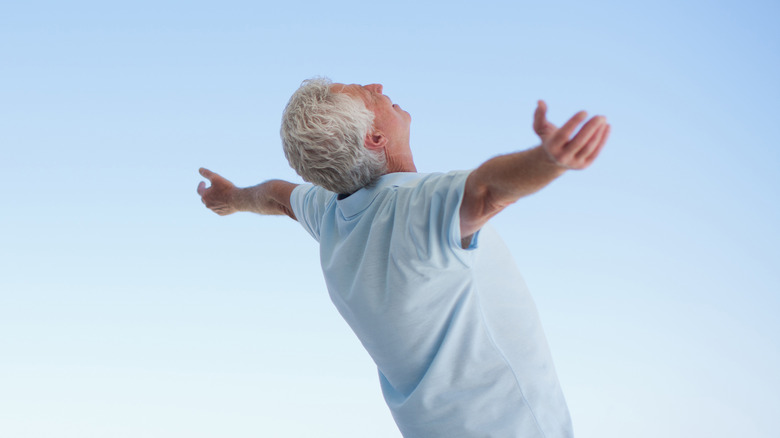Why Standing In One Place Is Much More Tiresome Than Walking
People who visit London are amazed at how the London bobbies can stand motionless for hours on end. After all, many of us get restless just standing in line for 20 minutes. We shift our weight from one foot to another, check our phones, and look around to see if anyone else is as uncomfortable as we are. Yet if we're asked to walk for 20 minutes, it doesn't seem to be as difficult — especially if we're walking at a casual pace.
It takes some serious effort to stand in place. According to Coastal Podiatry, your feet will begin to swell, and that builds pressure on your feet. If you're pecking at your phone while standing, you'll put even more pressure on your shoulders and neck. You're reducing your blood supply, which is why you feel tired standing in place. On the other hand, walking for the same amount of time keeps the blood flowing, as the muscles in your body distribute the work in propelling you forward. Standing for a short amount of time won't cause any damage, but longer periods of standing can pose significant health risks.
How standing for too long affects your body
If you aren't paying much attention to how you're standing, the arches in your feet will collapse and your feet tend to roll inward (via New York Times). You might not notice it at first. But over time, you can develop health problems. Nurses, teachers, wait staff, and hairdressers might notice stiff shoulders and necks, pain in the legs and feet, heel spurs, and plantar fasciitis, according to the Georgetown School of Nursing. A 2015 article in Rehabilitation Nursing found that standing for too long is linked to lower back pain, cardiovascular problems (like varicose veins and leg edema), and fatigue.
Your shoes can also do some damage to your feet, according to the American Podiatric Medical Association. Platform shoes and high heels will give you pain in the ball of your foot. Flats and slides tend to contribute to arch and heel pain because they lack cushioning. Peep-toe shoes put too much pressure on your toes, and wedges can make walking unstable. Love flip flops? They require a subtle-but-exhausting gripping action from your tendons and toes to keep them on your foot.
How to reduce standing fatigue
If your job requires standing a lot, or you know you're going to be standing for a while, you can reduce standing fatigue by wearing shoes that don't change the shape of your foot, according to Coastal Podiatry. You'll need a shoe with arch support and cushioning. The heel should have a strap or grip to keep it in place.
Rather than standing passively, adopt a more active stance by engaging your feet and legs. Rotating your kneecaps outward will avoid collapsing your arches. Staring at your phone will cause your shoulders to roll forward, so stand tall and draw your shoulders away from your ears. Look straight ahead and tuck your tailbone so your core is engaged. If walking isn't possible, try to flatten your back by pressing one foot on a step or curb.
You can also try the "One Stretch," which is a back extension exercise found to reduce lower back pain in a 2015 study in the Journal of Manual and Manipulation Therapy. Stand tall with your hands on your lower back and fingers pointing downward. Inhale, then on the exhale, stretch backward for three seconds.



